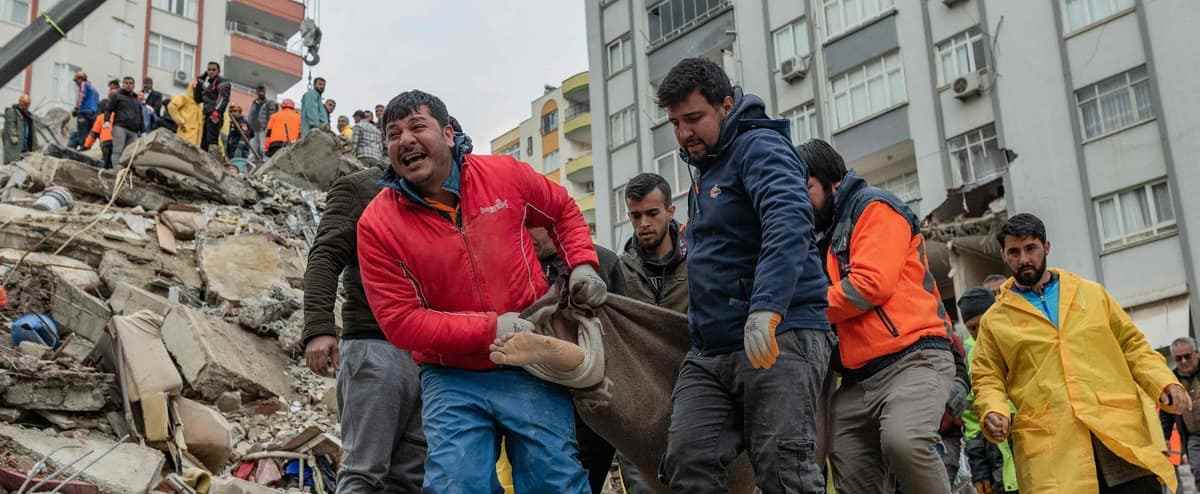The powerful earthquake that struck southern Turkey and neighboring Syria on Monday proved devastating due to a combination of factors: the time of its onset, its location, a relatively calm fault line for two centuries and poorly constructed buildings.
• Read also: Earthquake death toll rises to 2,300 in Turkey and Syria
• Read also: TO SEE | A building collapses a few steps from a journalist during his intervention
• Read also: IN PICTURES | In Jandairis devastated by the earthquake, death on every street corner
According to a provisional report around 2 p.m. GMT, more than 2,300 people died in this earthquake with a magnitude of 7.8, followed by a powerful aftershock of 7.5.
A balance sheet caused above all by the power of the event, unprecedented in Turkey since an earthquake in 1939, and which occurred in a very populated region.
The earth shook at 4:17 a.m. and all those who slept found themselves “stuck when their house collapsed”, notes Roger Musson, associate researcher at the British Geological Survey.
In addition, the construction of the houses “did not really correspond to an area at risk of major earthquakes”, explains to AFP this author of a book devoted to earthquakes. This could be explained by the fact that the seismic fault line, where these dwellings were located, was relatively calm in the past.
Turkey is located on one of the main seismic zones of the globe. In 1999, it recorded an earthquake on the North Anatolia fault, in the northern region of Düzce, which caused the death of more than 17,000 people.
On Monday, the earth shook on the other side of the country, near the Syrian border, along the Eastern Anatolia Rift.
The latter has not experienced tremors of magnitude 7 for more than two centuries, which may have led the population to “neglect the importance of its dangerousness”, according to Roger Musson. A duration which also means “that a fairly large amount of energy was able to accumulate” along the fault. Supposition supported, according to the researcher, by the occurrence of a powerful aftershock after the main shock.
Monday’s earthquake is “almost a repeat” of the one that occurred in the area on August 13, 1822 and whose magnitude was estimated at around 7.4 by seismologists. It had caused at the time “a huge amount of destruction, entire cities devastated and human losses amounting to tens of thousands”, recalled Roger Musson.
Monday’s earthquake struck at a shallow depth – about 17.9 kilometers – near the city of Gaziantep and its two million people. It was caused by a northward movement of the Arabian tectonic plate which is “advancing on Turkey”, explains the seismologist.
When the tension becomes too great, the plate suddenly advances and “the release of this movement produces a major earthquake, like the one we had today”.
The extent of the destruction also depends on the length of the ground rupture along the fault line (a hundred kilometers for Monday’s earthquake), notes the scientist. “This means that any point close to these 100 km was, in fact, at the center of the earthquake”.
The construction of buildings is a key factor when an earthquake occurs, notes Carmen Solana, a vulcanologist at the British University of Portsmouth.
“Infrastructural resistance is unfortunately uneven in southern Turkey and particularly in Syria. Therefore, saving lives now depends on the speed of relief,” she told AFP.
The 1999 earthquake in Turkey gave rise to legislation in 2004, obliging all new construction to comply with earthquake resistance criteria.
The extent of the destruction observed on Monday should lead the Turkish authorities to check whether the law has been respected, according to Joanna Faure Walker, of the Institute for Risk and Disaster Reduction, at the British university UCL.
Many buildings “collapsed like pancakes,” notes volcanologist Bill McGuire, also from UCL. “This happens when the walls and the floors are not sufficiently united, each floor collapses vertically on the one below”, leaving little chance of survival for the occupants, he explained.
“It’s not uncommon to see one building standing without major damage and the next completely flattened, due to questionable construction or poor materials.”

